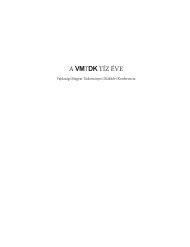Rezümékötet 2008. - vmtdk
Rezümékötet 2008. - vmtdk
Rezümékötet 2008. - vmtdk
You also want an ePaper? Increase the reach of your titles
YUMPU automatically turns print PDFs into web optimized ePapers that Google loves.
176<br />
H U M Á N T U D O M Á N Y O K<br />
The major purpose of the present research was to examine what results could be obtained from a corpus-based method<br />
in revealing normative language use in research paper introductions, especially in relation to collocation use in<br />
the individual rhetorical moves. To this end, an unnannotated comparable corpus of introductions has been built<br />
from 10 Hungarian and 10 English journal articles on human genetics. The corpus has been analysed relying on Swales’<br />
CARS model, and further subcorpora of the individual steps have been created. Despite the diminutive size of the<br />
corpus, the results of the analysis seem to suggest that not only the rhetorical structures and the larger linguistic units<br />
show conventionality in research paper introductions, but also the collocations comprising these structures and units.<br />
These findings may help translators follow the target language norms more closely by making them aware of recurrent<br />
normative syntagmatic patterns. In this way, the translators will also be able to keep more easily the generic identity<br />
of the source language genre in the target language.<br />
Keywords: collocation, norm, corpus, CARS model<br />
ULOGA NORMATIVNIH KOLOKACIJA CILJNOG JEZIKA<br />
U OÈUVANJU ŽANROVSKOG IDENTITETA IZVORNOG TEKSTA<br />
Autor: Gabriel ÈORBA II godina PhD studija<br />
Mentor: Dr Pal HELTAI univerzitetski profesor<br />
Institucija: Univerzitet Etveš Lorand, Filozofski fakultet, Odsek za prevoðenje i tumaèenje, Budimpešta<br />
Funkcionalni pristup prevoðenju pretpostavlja usklaðivanje izvornog koda normama ciljnog jezika. Poznavanje<br />
ovih normi je od izuzetne važnosti naroèito pri struènom prevoðenju, jer data diskursna zajednica oèekuje i od prevodilaca<br />
da se drže relevantnih registarskih i žanrovskih normi ciljnog jezika. Svrha ove analize je prema tome bila da se<br />
ustanovi u kolikoj meri je moguæe prikazati jezièku normativnost u uvodima struènih èlanaka koristeæi se metodom<br />
analize elektronskog jezièkog korpusa, naroèito u pogledu upotrebljenih kolokacija u datim retorièkim potezima. Da<br />
bismo postigli ovaj cilj, sastavili smo neanotiran dvojezièni uporediv korpus uvoda uzetih iz 10 maðarskih i 10 engleskih<br />
nauènih èlanaka na temu humane genetike. Èitav korpus smo rašèlanili na pojedine retorièke poteze i korake na<br />
osnovu Svejlzovog CARS modela, a zatim smo napravili pojedine podkorpuse za svaki retorièki potez. Iako je korpus<br />
bio premalen, kao rezultat se može pretpostaviti da je odreðen nivo jezièke konvencionalnosti u uvodima nauènih radova<br />
prisutan ne samo na planu retorièkih struktura i veæih jezièkih jedinica, veæ i na planu kolokacija kao njihovih<br />
sastavnih delova. Na osnovu ovoga se umnogome može olakšati praæenje normi ciljnog jezika u prevodilaèkom radu<br />
na taj naèin što se prevodiocima usmeri pažnja na one normativne sintagmatske šablone, koji doprinose oèuvanju žanrovskog<br />
identiteta izvorne poruke u ciljnom kodu.<br />
Kljuène reèi: kolokacija, norma, korpus, CARS model<br />
V I I . V A J D A S Á G I M A G Y A R T U D O M Á




